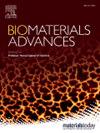微流体工程普鲁士蓝水凝胶微球增强骨关节炎抗氧化治疗
IF 5.5
2区 医学
Q2 MATERIALS SCIENCE, BIOMATERIALS
Materials Science & Engineering C-Materials for Biological Applications
Pub Date : 2025-05-13
DOI:10.1016/j.bioadv.2025.214345
引用次数: 0
摘要
骨关节炎(OA)是一种退行性关节疾病,是全球致残的主要原因,给社会和家庭带来了沉重的负担。目前针对OA的抗氧化治疗存在靶向性差、疗效短暂等问题,无法解决过度活性氧(ROS)驱动的发病机制。在此,我们通过微流体工程创新地将普鲁士蓝(PB)纳米酶与海藻酸透明质酸(HA)水凝胶微球结合在一起,创建了可注射的AlgHA@PB平台,该平台协同双重治疗机制:通过PB纳米酶清除ROS和氧气生成,以及通过水凝胶微球结构实现持续的关节内保留和机械相容性。体外研究表明AlgHA@PB清除了细胞内所有的ROS,同时不断释放细胞内的氧气。在大鼠OA模型中,AlgHA@PB表现出延长关节潴留和减少软骨退变。关键是,微球表现出稳定的摩擦系数,使关节内运动平滑而没有机械刺激。本研究建立了AlgHA@PB作为一个集抗氧化防御、抗炎作用和生物力学相容性为一体的多功能OA治疗平台。微流体工程设计确保了可扩展的生产,符合临床翻译要求。本文章由计算机程序翻译,如有差异,请以英文原文为准。
Microfluidic-engineering Prussian blue hydrogel microspheres for enhanced osteoarthritis antioxidant therapy
Osteoarthritis (OA), a degenerative joint disorder and leading cause of global disabilty, imposes substantial societal and familial burdens. Current antioxidant therapies for OA are hindered by poor targeting and transient efficacy, failing to address the excessive reactive oxygen species (ROS)-driven pathogenesis. Herein, we innovatively integrate Prussian blue (PB) nanozymes with alginate-hyaluronic acid (HA) hydrogel microspheres through microfluidic engineering, creating the injectable AlgHA@PB platform that synergizes dual therapeutic mechanisms: ROS scavenging and oxygen generation via PB nanozymes, and sustained intra-articular retention and mechanical compatibility enabled by the hydrogel microsphere architecture. In vitro studies demonstrated that AlgHA@PB scavenged all of intracellular ROS while continuously releasing oxygen within. In a rat OA model, AlgHA@PB exhibited prolonged joint retention and reduced cartilage degeneration. Critically, the microspheres demonstrated a stable friction coefficient, enabling smooth intra-articular motion without mechanical irritation. This study establishes AlgHA@PB as a multifunctional OA therapeutic platform that integrates antioxidative defense, anti-inflammatory action, and biomechanical compatibility. The microfluidic-engineered design ensures scalable production, aligning with clinical translation requirements.
求助全文
通过发布文献求助,成功后即可免费获取论文全文。
去求助
来源期刊
CiteScore
17.80
自引率
0.00%
发文量
501
审稿时长
27 days
期刊介绍:
Biomaterials Advances, previously known as Materials Science and Engineering: C-Materials for Biological Applications (P-ISSN: 0928-4931, E-ISSN: 1873-0191). Includes topics at the interface of the biomedical sciences and materials engineering. These topics include:
• Bioinspired and biomimetic materials for medical applications
• Materials of biological origin for medical applications
• Materials for "active" medical applications
• Self-assembling and self-healing materials for medical applications
• "Smart" (i.e., stimulus-response) materials for medical applications
• Ceramic, metallic, polymeric, and composite materials for medical applications
• Materials for in vivo sensing
• Materials for in vivo imaging
• Materials for delivery of pharmacologic agents and vaccines
• Novel approaches for characterizing and modeling materials for medical applications
Manuscripts on biological topics without a materials science component, or manuscripts on materials science without biological applications, will not be considered for publication in Materials Science and Engineering C. New submissions are first assessed for language, scope and originality (plagiarism check) and can be desk rejected before review if they need English language improvements, are out of scope or present excessive duplication with published sources.
Biomaterials Advances sits within Elsevier''s biomaterials science portfolio alongside Biomaterials, Materials Today Bio and Biomaterials and Biosystems. As part of the broader Materials Today family, Biomaterials Advances offers authors rigorous peer review, rapid decisions, and high visibility. We look forward to receiving your submissions!

 求助内容:
求助内容: 应助结果提醒方式:
应助结果提醒方式:


